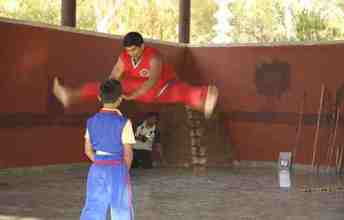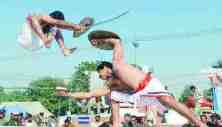Free, Online Resources to Learn Malayalam!
Kalari
Kalaripayattu  Kerala Kerala
Kalari Background
Kalarippayattu is a martial art with origins in Kerala and practised in the south Indian state. It incorporates strikes, kicks, grappling, choreographed martial art sequences, and weaponry, as well as healing techniques used in Ayurveda
Kalari has similar systems to Chineses medicines and fighting using pressure points and Acupressure. Marmams () are vulnerable parts of the human body: Skilled Kalari practitioners can disable or kill their opponents by a mere touch in a Marmam. Marmam is taught only to the promising and level-headed persons, to forbid misuse of the technique.
The term Kalarippayattu is formed from the words kalari (Malayalam: കളരി) meaning school or gymnasium and payattu (Malayalam: പയററ്) derived from payattuka meaning to fight or to exercise or to put hard work into.
M.D. Raghavan has suggested that Kalari was derived from the Sanskrit khalūrikā, Burrow is of the opinion that khalūrikā ("parade ground, arena") and its Sanskrit root, khala- ("threshing floor") are Dravidian loan words.
Kalarippayattu became more developed during the 9th century and was practiced by the a section of the Nair community,warrior clan of Kerala, to defend the state and the king
Kalari underwent a period of decline when Nairs lost to the British after the introduction of firearms and especially after the full establishment of British colonial rule in the 19th century. The resurgence of public interest in Kalarippayattu began in the 1920s in Tellicherry as part of a wave of rediscovery of the traditional arts throughout South India and continued through the 1970s surge of general worldwide interest in martial arts. In recent years, efforts have been made to further popularise the art, with it featuring in international films. Some dance schools in Kerala incorporate kalarippayattu as part of their exercise regimen.

KRISHNA PRATHAP - Kalaripayattu Instructor in 'SHANKARAA VALLABHATTA KALARI. He is 5 times state champion of kerala.
Styles of Kalari
There are many different styles of Kalarippayattu. If one looks at the way attacks and defences are performed, one can distinguish three main schools of thought: the northern styles, the central styles, and the southern styles. The best introduction to the differences between these styles is the book of Luijendijk.
Northern Kalarippayattu
Northern Kalarippayattu (practiced mainly in  in the northern Malabar region of Kozhikode and Kannur) places more emphasis on weapons than on empty hands. Masters in this system are usually known as gurukkal. The northern style of Kalarippayattu have been practiced primarily by Nairs and Kuruppu(Chekavar). in the northern Malabar region of Kozhikode and Kannur) places more emphasis on weapons than on empty hands. Masters in this system are usually known as gurukkal. The northern style of Kalarippayattu have been practiced primarily by Nairs and Kuruppu(Chekavar).
Northern Kalarippayattu is distinguished by its meippayattu - physical training and use of full-body oil massage. The system of treatment and massage, and the assumptions about practice are closely associated with Ayurveda. The purpose of medicinal oil massage is to increase the practitioners' flexibility, to treat muscle injuries incurred during practice, or when a patient has problems related to the bone tissue, the muscles, or nerve system. The term for such massages is thirumal and the massage specifically for physical flexibility chavutti thirumal. There are several lineages (sampradayam), of which the arappukai is the most common nowadays. There are schools which teach more than one of these traditions. Some traditional kalaris around Kannur, for example, teach a blend of arappukai, pillatanni, and katadanath styles.
Southern Kalarippayattu
-
- In southern styles of Kalarippayattu practice and fighting techniques emphasize empty hands and application from the first lesson. In the southern styles the stages of training are Chuvatu (solo forms), Jodi (partner training/sparring), Kurunthadi (short stick), Neduvadi (long stick), Katthi (knife), Katar (dagger), valum parichayum (sword and shield), Chuttuval (flexible long sword), double sword and Marmma and kalari grappling. The southern styles of Kalarippayattu have been practiced primarily by a section of Nairs and Ezhavas in Kerala.
Zarrilli refers to southern Kalarippayattu as Varma ati (the 'law of hitting') or marma ati (hitting the vital spots). The preliminary empty-hand techniques of Varma ati and Adithada (hit/defend). Marma ati refers specifically to the application of these techniques to vital spots. Southern styles of Kalarippayattu are not usually practiced in special roofed pits but rather in the open air, or in an unroofed enclosure of palm branches. Masters are known as 'asaan rather than gurukkal (in Northern style). The founder and patron saint is believed to be the rishi Agasthya.
Medical treatment in southern styles of Kalarippayattu—which does include massage—is identified with Dravidian Siddha medicine, which is as sophisticated as though distinct from Ayurveda. The Dravidian Siddha medical system is also known as Siddha Vaidyam is attributed to the rishi Agasthya.
Silambam is a stick fighting, part of southern style of Kalarippayattu. This style supposedly originates from the Kurinji hills, present day Kerala, 5000 years ago, where natives were using bamboo staves to defend themselves against wild animals. "Salambal" is a common word used to denote the sound of fast flowing rivers/springs, the chirping noises of birds, the murmur of leaves, the noise created by blah blah ing of a crowd, the whooshing, whirring and clanging sound of weapons etc. When long sticks, swords and chain flails are used they produce the "sala sala" sound which is called "salambal". Thus Silambam became the name of the martial art that uses long sticks, swords etc.
Central Kalarippayattu
The central style (practiced mainly in Thrissur, Malappuram, Palakkad and certain parts of Ernakulam districts is 'a composite' from both the northern and southern styles that includes northern meippayattu preliminary exercises, southern emphasis on empty-hand techniques, and its own distinctive techniques, which are performed within floor drawings known as kalam.
Kalari Videos
History of Kalari
Philosophy of Kalari
Benefits of Kalari
Kalari Vocabulary Terms
Kalari Training Tips
Recommended reading
- Balakrsnan, Pi (1995) Kalarippayattu: The ancient martial art of Kerala, C.V. Govindankutty Nair Gurukka 1995, ASIN B0006F9ONS
- Denaud, Patrick (1996) Kalaripayat, Budostore, ISBN 2-908580-62-4
- Elgood, Robert (2005) Hindu Arms and Ritual: Arms and Armour from India 1400-1865, Eburon Publishers, ISBN 90-5972-020-2
- Luijendijk, D.H. (2005) Kalarippayat: India's Ancient Martial Art, Paladin Press, ISBN 1-58160-480-7
- Luijendijk, D.H. (2008) Kalarippayat: The Essence and Structure of an Indian Martial Art, Oprat, ISBN-13: 978-1409-2262-60
- Zarrilli, Phillip B. (1992) "To Heal and/or To Harm: The Vital Spots in Two South Indian Martial Traditions"
- Zarrilli, Phillip B. (1993) "Actualizing Power and Crafting a Self in Kalarippayattu", Journal of Asian Martial Arts
Additional Martial Arts Resources
.

|

